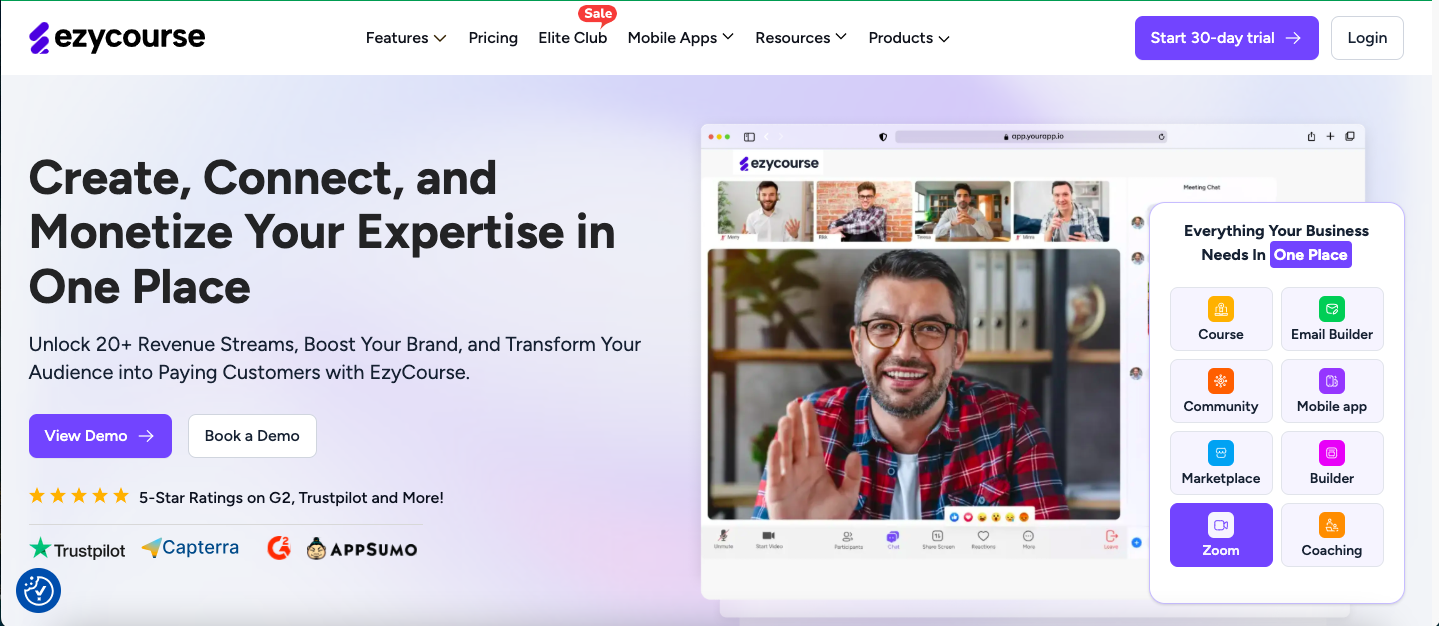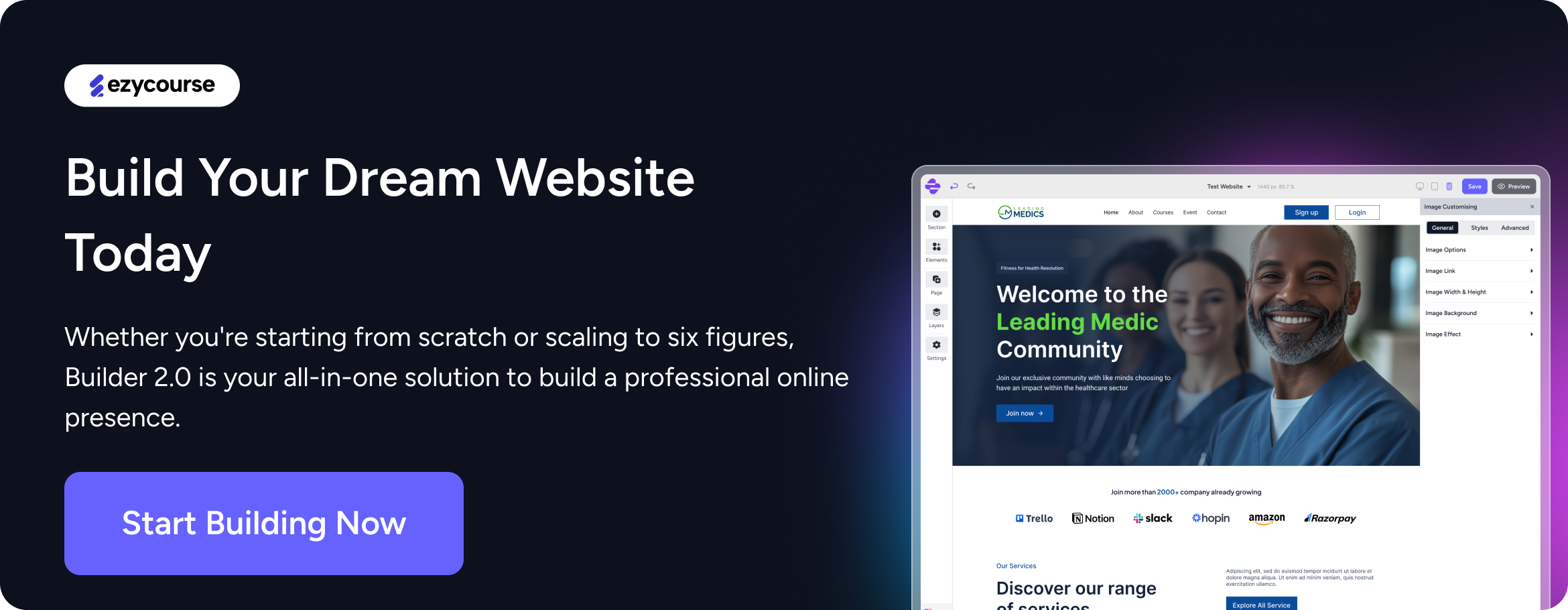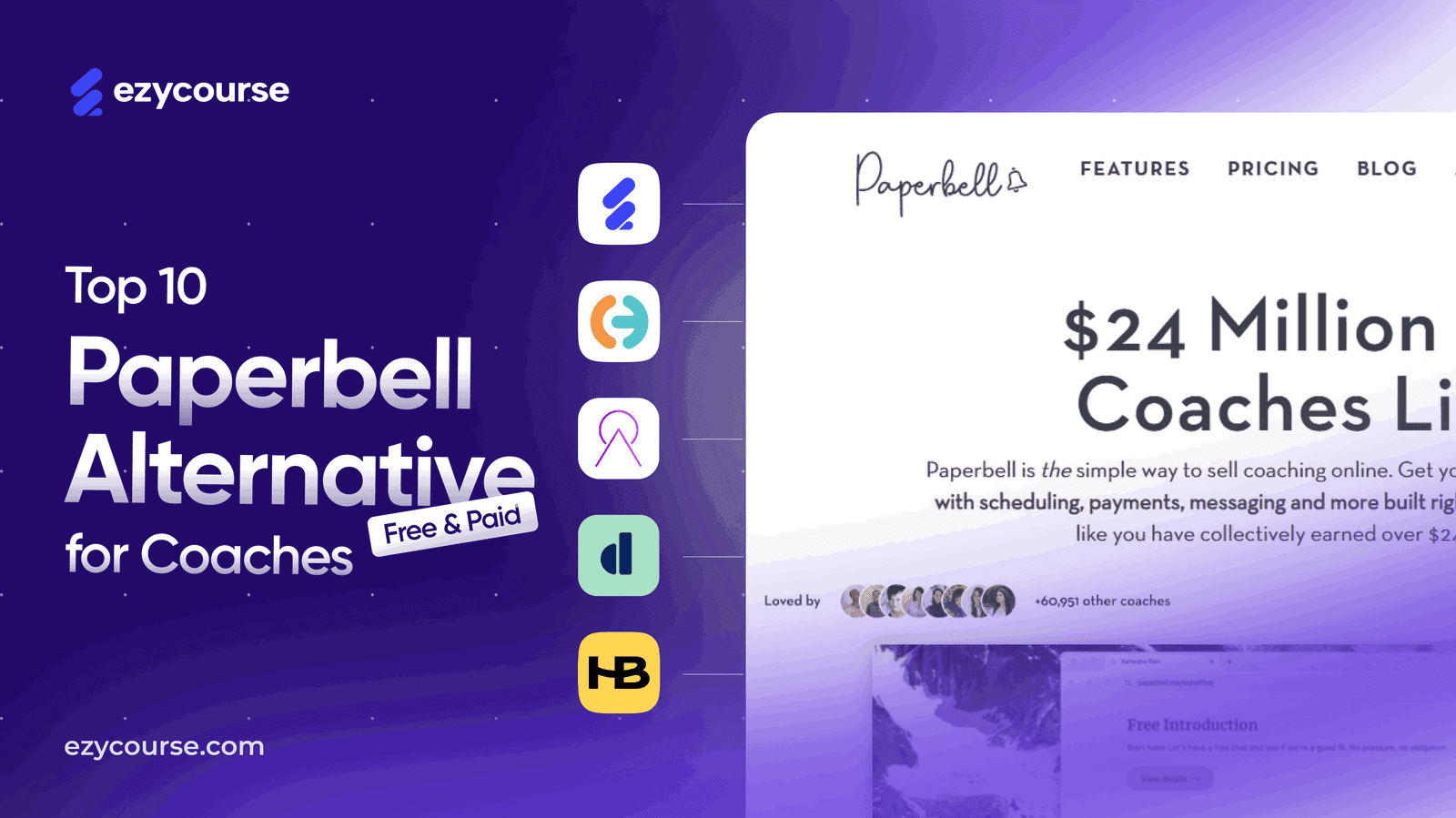The e-learning industry is booming as a whole, and it’s not stopping anytime soon! In fact, it is expected that the market will project $400 billion by 2026. Undoubtedly, that means there is no better time than now to start an online education business!
But let’s be honest here! Maybe you’ve got the passion to share, or you are an experienced one in this sector. Either way, it can be difficult to start an e-learning business. However, it doesn’t have to be complicated if you follow the right steps.
With the clear plan, strategy, and right tools, you can very easily launch your online business in education. Speaking of which, we’ve discussed the entire process into 10 simple steps on how to start an online education business. Just keep reading.
What Is an Online Education Business?

The online education business offers e-learning experiences through digital platforms. It allows individuals to access courses, training, or tutoring from anywhere.
The business may offer self-paced video or live classes. Some businesses also offer hybrid models combining both.
Unlike the traditional classroom, online education businesses are more cost-effective and scalable. On top of that, global e-learning marketing demand is also growing.
According to The Business Research Company, the e-learning market size is projected to grow from $314.03 billion in 2024 to $354.71 billion in 2025. Here, with the compound annual growth rate (CAGR) of 13.0%.
This rapid growth indicates a great opportunity for entrepreneurs to enter the online education sector.
Not sure how to create e-learning courses? Read the full guide now!

Why Start an Online Education Business Now?
Where, after the COVID-19 pandemic, everything has shifted to online, and still has not slowed down, the education business is no exception.
So, it’s worth pointing out why starting one now is strategic and lucrative.
Low Startup Capital
In some cases, many newcomers avoid starting a business because of the initial high startup capital. But that’s not the case with the online education business.
You will need very little capital to start your business—initially, just for the tools and the sound equipment. The costs of these items are comparatively low.
Initial marketing of the business is also affordable. You can start promoting your business on platforms like Facebook, Twitter, Instagram, Reddit, and more.
More Income Potential

One of the most lucrative benefits of the online education business is that the income potential is likely to increase daily.
Wondering why?
That’s only because of its effectiveness. Stats show that the successful online educators earn $1k to $10k per month on average.
The overall income rate of online education is increasing, and also the earning potential, just as Andrea pointed out!
Flexible Work Hours
With the online education business, it is totally up to you how many hours you want to dedicate to your business.
You can choose whether you want to do a part-time or full-time project. It allows you to set your own curriculum and create your content based on your own experience and philosophy.
Of course, it can be a surefire way to stand out in the competition! Plus, online teaching is one of the coolest ways to earn passive income.
Global Reach
Your online education business will not be limited to your local area any longer! If you are willing to promote your online course globally, you can do so with digital platforms.
It makes it possible for you to reach the students across the globe and allows the students to learn on their own time.
How to Start an Online Education Business? [10 Simple Steps!]

Now that you know what is online education business is and why you should launch one, the question still remains- how to start it. Check out the steps on how to start an online education business below.
Step 1: Validate the Market
Validate the market. It is the first step you must do! It means first confirming where there is a real demand for your online course ideas before creating it. Through this, you can ensure your efforts directly match the target audience.
So, first you have to decide:
What will you teach?
In what topic are you an expert to teach others? And
For what topic do you want to become known for?
After giving a clear answer to these questions, move ahead to proper market validation.
It will help you avoid wasting your resources, give you an idea of income predictability. Moreover, you can identify your competitors.
“My greatest suggestion is to start with your research. You should look at other people who create courses on your topic, see how they frame and position it, and analyze whether they are successful”.
Business Growth Consultant and Course Creator
Here is how you can do so.
I) Conduct Market Research
It is crucial to understand who your learners are and what they really need.
You will be able to know the pain points and expectations of the readers by conducting a thorough market research. You can use tools like SurveyMonkey or Google Forms to run quick surveys and polls.
It is also a good idea to ask directly your potential learners what they want to learn.
II) Analyze Search Trends
You can learn what people are actively looking for online by analyzing the search trends. Here, Google Trends, or AnswerThePublic, helps to discover popular keywords and trending topics in your niche.
So, you will be able to align your course idea with the learners' demand.
For example, let’s say you have noticed many searches on "freelancing skills for beginners" or "learn Excel for data analysis,".
Following the trend, now you can create content that is relevant to the requirement.
III) Analyze The Competition
Analyze your competitors to find out where you can stand out. You should check their content, their niche, pricing, reviews, and marketing strategies.
Try to identify their gaps and your opportunities. It will help you to improve your own approach and place your course in the market more effectively.
Step 2: Create The Business Plan for Your Online Education Business

Now that you have decided what to teach and validated your course idea, it is time to get the plan ready.
A business plan is like a blueprint that will describe how you will structure your course, manage or market it. Every business is different, even for education. For this reason, business plans and models vary greatly.
However, when making a business plan, you need to ensure the plan remains competitive and successful financially.
Below are some aspects that remain common and you need to include in your business plan.
I) Decide Your Business Model
Next, you have to choose the business model. It is important to choose a model to build a profitable online education business.
There are a few popular business models you can consider.
Subscription-based model
In this model, the students pay monthly or annual fees for accessing your course. The model is ideal for the continuous learning courses.
Freemium model
It is the smart way to attract new learners. Here, you allow your audience to experience your teaching style for free before committing to the paid content.
Membership model
If your course includes discussion, mentorship, forum, or continuous interaction, this model will work well. The model is great for building trust in the community.
Pay per class model
Here, learners pay for the individual classes or lessons. It offers flexibility to those who have a specific interest in your course.
II) Hiring and Team Management
Generally, most of the online course creators choose to run their business on their own.
But in some cases, they may need to hire a full-time employee or virtual assistant for help. Some of the businesses even choose to delegate some tasks to freelancers.
If you are also going to opt for one, ensure to set clear roles. Moreover, build clear communication channels.
Remember that you can maintain the course efficiently with proper team management.
III) Business Operations
You will need to have a clear plan to manage your daily activities.
The following things should be included in your business operation plan-
When will your operations run
How you’ll structure your content release schedule,
Any tech or communication tools you’ll rely on (like Zoom, LMS platforms, or support chat)
Also include the practical essentials. For instance, data security and reliable internet infrastructure
IV) Finances
No matter what your business is, it requires money to run. You will need to have the budget for tools and tech infrastructure. So, also include it in your selling and business monetization plan.
In this way, first make a detailed budget. Divide the resources fairly and avoid overspending. Try to keep everything within your budget.
You’ll need to track two metrics in this regard:
Gross Profit Margin
These metrics show how much profit you can make after covering the related costs.
Gross Profit Margin = (Net course sales revenue – course costs) / Net revenue × 100
SG&A Ratio (Selling, General and Administrative Ratio)
This tells you how much of your earnings go into running the business. The metric is-
SG&A Ratio = (Selling + General + Admin costs) / Net course revenue
V) Decide On Your Marketing Strategy
How you intend to promote your online education business is also an important part of your business plan.
You should think about who your target audience is and through which channel you will reach them.
Step 3: Create A Unique Brand

In simple words, branding is all about positioning. Branding does not necessarily mean you should start with a website, logo, or business cards.
True, they are important, but not at the starting point. Here, you need to clarify how you want to be seen in the industry.
You will need to position yourself as a go-to expert in this field. Here is what you need to do.
I) Be Strategic
A common branding mistake among the course creators is that they try to attract everyone. But you have to be strategic in positioning yourself.
You know, successful brands are focused! They speak directly to a specific audience.
Hence, you should clearly define how you want to be known in the market. Identify your target learners and distinguish them from those who are not.
Now, you should create a main value that shows what your brand stands for. Explain the results or benefits your course will offer to the learners.
These two elements ensure your message reaches and connects with the right audience.
II) Identify Your Value Proposition
Your value proposition is what makes your course business stand out. It defines what you offer, who you serve, and why it matters.
In this regard, you need to get clear on three things.
Who are you helping?
What are you helping them achieve?
Why is that important for them?
After you have these answers, bring them together in one strong sentence. It will become your Unique Value Proposition.
This UVP will tell your audience exactly why they need to choose you over others. It builds trust and helps the learners to connect with your message instantly.
Did you know that the all-in-one course platform, EzyCourse, lets you create a fully branded website and get a free white-label mobile app under your brand name? Why wait then!
Step 4: Choose an Online Course Platform
Whether you’ve been teaching for years or you’re just starting with an idea, choosing the right online platform is one of the most important steps.
That is because the online course platform is where you’ll create your course and share your lessons. More importantly, through these platforms, you will connect with your students and build your business.
In this way, if you don’t have any experience, go for an all-in-one platform. It will handle everything for you—course creation, payments, student logins, and more.
Now, let's say you are someone who already has experience in this sector. Then you should opt for a strong platform that can help you grow faster.
It allows you to focus on what matters most. For instance, you can focus on creating great content where your platform will manage the technical side.
To save you from the hassle of choosing the right platform for starting your online education, here are our top picks as a learning management system that you can consider.
I) EzyCourse

EzyCourse is an all-in-one platform and is designed to make course creation easy for everyone. It’s especially great if you want an easy-to-use interface that handles everything.
You don’t need to have technical skills. The platform will handle it all from building courses to accepting payments. If you are a beginner, you will appreciate its step-by-step guidance.
As for the experienced ones, they can take advantage of its powerful marketing and community-building tools.

Step 5: Build and Launch Your Online Course
Creating your online course is likely to be the most exciting stage. However, in this stage, it is very easy to get stuck in the details. That’s especially when you are a beginner.
Most often, it is seen that many beginners spend weeks and even months trying to make everything perfect. Instead of it, you should focus on creating a Minimum Viable Course (MVC).
What is it, right?
You can say A Minimum Viable Course (MVC) is the simplest version of your course that will deliver meaningful results. It focuses on teaching only the essential knowledge or skills your audience needs to achieve a specific outcome.
The MVC allows you to launch quickly, gather feedback, and improve based on student experience rather than trying to create a perfect course. It helps you save your time and avoid guessing what your audience truly needs.
That’s why you should first start by outlining the course
Define your course title and subtext.
Map out the learning outcomes
Gather your content and choose how to deliver each module (video, audio, PDF, etc.)
Record and edit your lessons
Set up your course platform and pricing
Write a compelling sales page
You don’t need to try to add everything you know. Instead, it should be clear and focused on outcomes. Always keep in mind that students value clarity and results more than long hours of content.
Next, launch your online education business smartly. At the starting point, you can offer your course to a smaller group at a discounted rate. This is called “beta launch”.
This smaller approach helps you collect feedback, find areas for improvement, and gather testimonials. You can use that insight to modify your course before the full-scale release.

Step 6: Next, Build Your Audience
You know it is a very crucial step. The reason is simple: if your audience does not know or trust you, they are not likely to buy your course.
In such a scenario, selling the course will be challenging. That is why you should focus on building your audience.
Don’t just focus on quantity. You should try to build meaningful relationships and engagement with your learners.
Below are some effective ways to grow your audience.
Social media
You will need to choose at least two or three social media platforms where your target audience spends more time. Share your content and engage in conversation.
Content marketing
You can also consider publishing free articles, videos, podcasts, or infographics regularly. It will help to build trust and authority.
Email marketing
You should make your email list early and try to send helpful content consistently. It will help to build trust even before promoting your course.
Networking and collaborations
It is also a wise idea to connect with industry experts for guest blogging, interviews, or partnerships.
Public speaking
You can present at events your audience attends to gain direct exposure and build credibility.
Paid advertising
Last but not least, use platforms like Facebook, Google, or LinkedIn to target specific audiences and generate leads.
Step 7: Decide Your Course Pricing and Effective Payment Gateway
Pricing of the online education, honestly speaking, has a make-or-break ability for a business. Here, you are not just covering the cost! Instead, you want to find a sweet spot where the learners see value in engaging.
There are more than a number of course pricing and payment structure options you can consider. However, the following are a few important factors you should weigh in this regard.
Analyze your competitors: First, analyze what your competitors are offering and their pricing. It will give you valuable insight about pricing.
You will be able to set a realistic and competitive price by understanding where your course fits in the market.
Choose the right pricing model: You should choose a pricing structure that aligns with both your content and audience. For instance
One-time fee- It will be ideal if your content does not need regular updates.
Subscription model- This model will be great when you are planning to add fresh content regularly
Tiered pricing- If you want to offer different levels of access, like basic and premium, this pricing model will work well.
Next, add a secure payment gateway. If you use EzyCourse, you will get a lot of payment gateways to connect to your site.
As the online education business is completely held online, having a secure and easy payment gateway is obviously important. You should ensure a simple and easy, but secure one for the best user experience.
Moreover, you should choose a gateway that supports multiple currencies and offers flexible payment options (like credit cards, PayPal, Stripe, or local methods).
More importantly, the payment gateway should be accessible for every user and must include built-in fraud protection.
Step 8: Market Your Online Business

After all is done with creating and launching your online education business, the most important thing now is to get people to see what you offer.
That’s why it is strongly recommended to focus on how you are going to market your education product to your target audience.
Below are five proven marketing strategies that can help you build visibility and grow your audience.
I) Create a Website
Honestly speaking, you don’t need to have a website to start an online education business. But if you are serious in this regard, you must have. It can significantly enhance your credibility and growth potential.
You can create valuable content like blog posts or free resources that attract organic traffic from search engines through your website. It will help you to reach a new audience without ongoing ad costs.
Moreover, with its help, you can capture leads and build an email list. It can be helpful to expand your reach.

II) Email Marketing Campaigns
Email marketing campaigns are still one of the most effective tools to promote your online business. It can effectively build a direct and ongoing relationship with the audience.
Once your audience joins your list, you can send them newsletters, course updates, launch announcements, and exclusive offers directly to their inbox.
Email marketing also enhances your leads. It is possible that some people may not buy your course immediately. But your consistent, value-driven emails can gradually convert interest to sales.
III) Social Media Marketing

Social media marketing allows you to build brand awareness and connect with your target audience directly.
You can show your expertise and engaging course-related bite-sized content on platforms like Instagram, LinkedIn, and YouTube.
Start with one or two platforms where your target learners are active. You can use your posts to educate, inspire, and create trust.
You should also consider live videos as they can enhance engagement and drive direct interest in your offer.
Related Read: 10 Powerful Social Proof Examples To Boost Trust In Your Business
IV) Affiliate Marketing
Affiliate marketing is somewhat you are letting others promote your course for you. Plus, you only pay when they deliver results!
Wondering how?
Here is how it works- you give your affiliate partners a unique link to share. When someone buys your course through that link, they earn a commission.
Ultimate result? —You gain exposure and they earn for their effort! It’s a win-win situation for both parties and a smart way to grow without spending upfront on ads!
V) Paid Ads
Paid ads can also help you reach more potential learners. The best part? —You can target exactly who sees your messages.
Platforms like Meta (Facebook and Instagram) or Google Ads help to reach your target audience based on interests, behaviors, or even search terms.
You can start by promoting a free resource, like a checklist or webinar, instead of selling your course directly. It helps your audience get to know you before you offer them something to buy.
Run test campaigns, analyze what actually works. All in all, paid ads can bring you steady traffic, but with the right offer and messaging.
VI) Content Marketing
Content marketing is one of the most sustainable ways to attract, engage, and convert your ideal learners. Content comes in many forms, blog posts, YouTube videos, podcasts, infographics, or even mini-courses.
The key is to educate and solve real problems your audience faces. When they find your content helpful, they're more likely to see your paid course as the next logical step.
For example, you can structure a blog post for SEO that addresses a common challenge in your niche and offer your course as a deeper solution. Or, make a free video series that builds anticipation for your paid program.
Thus, content marketing builds long-term visibility, nurtures trust, and brings in warm leads who are ready to buy.
Step 9: Measure ROI of Online Education Business
When you are starting an online education business, the ROI or Return on Investment is also essential.
It helps you determine the success of your business and set the benchmarks for future growth.
As for the ROI estimation, it is frequently calculated following this traditional formula:
ROI = [Net program benefits / Program cost] x 100
To determine the average education business ROI, simply divide the amount of money you have made by its implementation cost. Then multiply the result by 100.
For example, let’s say your course brings in $12,000 in revenue. Your total cost was $4,000 —including course creation, platform tools, and ads. That’s a 200% ROI. It indicates a strong performance.
It means that when the benefits and the value of your program outweigh the implementation cost, you can say your online education business efforts are a success.
With the regular measurement of ROI, you can
Identify which course or marketing efforts have worked best
Find out the areas where you are overspending
Make adjustments in the pricing and marketing strategy to save time and money.
Step 10: Scale Your Online Education Business
Once your course is live and generating sales, the next step is to scale the growth. It is actually about targeting to increase the revenue and reach out even without burning yourself.
Here is how you can take your online education business to the next level.
I) Add More Courses
Your first course validates your idea. Now you can try to expand your offering with more course series and related modules.
Think about how you can create a learning path for your students supporting continuous growth. You can cover different courses and modules for different levels—beginner to expert.
It will not only enhance your income per customer but will also help you build long-term loyalty from your learners.
II) Automate Your Workflow
Coming to the next, take advantage of automation. Use automation tools to handle repetitive tasks. For instance, enhancing lead, onboarding, follow-ups, and course reminders.
To give you examples:
You can use learning management systems like EzyCourse, which offers an email automation workflow builder to send trigger-based emails.
Also, consider setting up automated welcome sequences to guide students through the course.
Benefits of this approach? It will allow you to grow your business, and more importantly, you don’t even have to constantly trade your time for money.

III) Partner with Creators and Influencers
Partnering with creators and influencers is one of the fastest and most cost-effective ways to scale your online education business.
Strategic partnerships allow you to get new audiences, build trust quickly. Plus, you can even multiply your impact, without relying heavily on ads or growing your list from the beginning.
You can follow the ideas below in this regard.
Co-create a course or bundle your products with others in your niche.
Run joint webinars or workshops to cross-promote.
Set up an affiliate program where others earn a commission for promoting your course.
IV) Build A Membership Model
Creating membership models means you will offer ongoing access to your courses, exclusive content, and community for a recurring fee, instead of just one-time course sales.
It will transform your business from a one-off transaction into a steady income stream. How can you do so?
Check the quick rundown below.
Choose your subscription plan and create tiered pricing options.
Package your courses with exclusive content and build a private member community.
Use platforms like Teachable or Podia to manage subscriptions and automate billing.
Launch with a special offer and consistently add fresh content to keep members engaged.

How Much Can You Earn from an Online Education Business?

[A Research by GetResponse]
Here’s the kicker: the online education business is one of the few models where you can expect lucrative income. Moreover, you can enhance your income without trading more of your time.
From the online education business, you can earn anywhere from $0 to over $50,000 per month. However, that will depend on your niche, pricing, and marketing efforts.
Still, on average, it is seen that most successful online course creators and educators earn between $1,000 and $10,000 per month. This amount translates to $12,000 to over $100,000 annually.
That’s not it!
According to the State of Creators 2024 Report, 40% of top earners reached six figures within just two years of starting.
Moreover, it is expected that by 2025, the average revenue per user (ARPU) in the online education market is projected to reach $218.77.
That highlights clearly how strong the earning potential this online education industry offers, right?
Challenges with Starting an Online Education Business
It is not enough just to know how to create an online business or sell it. You must also be aware of the challenges that come your way to be prepared beforehand.
Let’s get to know it below.
I) Tech setup
The first big challenge that the online education businesses face is setting up the right technology infrastructure.
As you see, you will need to choose the right LMS platform, integrate the payment methods, and even handle the student data. Mistakes in setup can affect user experience and cause dropouts.
So, as a beginner, you should use beginner-friendly platforms like EzyCourse. You should ask for customer support and even consider hiring freelance help.
II) Low engagement
It can be really difficult to keep the learners motivated and active. Sometimes, many students start courses but drop out early if the content is not engaging.
That’s why you should focus on building engaging content from the very first. You should consider adding interactive elements like quizzes or assignments, forums, or live Q&A sessions.
III) Marketing pressure
That’s not a secret. No matter how good your course is, it won’t sell if no one knows about it. On the other hand, constantly marketing can be stressful and take time. Competition is high—many others offer similar courses, so standing out is difficult.
You need to constantly find and attract new students to keep sales going. A clear marketing plan can help you a lot to handle this challenge.
How To Start An Online Education Business with EzyCourse

When you want to start and grow your online education business with ease, EzyCourse makes it simple and powerful. No matter whether you are new in this field or an expert, the platform offers you all the more than essential features.
Have a quick overview below.
Course Creation: It supports 13 lesson types, including video, audio, SCORM, quizzes, and more. Ultimately, it allows diverse content delivery.
Website Builder: It offers a drag-and-drop builder with over 250 templates. It enables easy customization of your online school.
Branded Mobile App: The platform provides a white-label mobile application for both iOS and Android. It enhances accessibility for students.
Community Engagement: It helps you in community building through group chats, forums, and live sessions.
Monetization Tools: The platform includes features like tiered pricing, smart upselling, and affiliate programs. These features help you to maximize revenue.
Email Marketing: EzyCourse has built-in email automation with event-based triggers and segmentation options. It assists you in maintaining personalized communication.
Read the full guide to learn how to teach a course online from start to end.
Final Words
All in all, launching an online education business does not have to be a daunting task. You just need to focus on delivering the real value. Stay consistent and always listen to the feedback of your learners. As your business grows, modify your approaches.
Moreover, you should try to use an all-in-one platform like EzyCourse as you are launching your business for the first time. Most importantly, don’t wait for perfection. Aim for steady progress and get your business to grow!

FAQs
Have more queries about how to start an online education business? Let’s try to address some of your common concerns through the queries that are readily asked by people.
Do I need a business license to teach online?
Typically, when you are teaching online private tutor or providing an online course, it doesn’t require a business license in most jurisdictions. However, it is wise to understand the local regulations or requirements for operating as a business.
How to start an online tuition business?
First, identify your niche and create a business plan. Then set up your online presence, define your service to your audience, and pricing. Now market your online tuition business through online advertising or networking.
Is online tutoring lucrative?
Yes definitely! Online tutoring is lucrative and can be a profitable endeavor. Through an online tutoring business, you can expect to earn $15 to $100 per hour or more. However, it’ll depend on the subject you have chosen or your experience.
Do I need an LLC for an online personal education business?
Frankly speaking, legally, it is not mandatory to have an LLC for a personal education business. You can operate your business as a sole proprietor if you have a one-person company. However, forming one can offer you advantages like liability protection, credibility, and trust.
Do I need to copyright my online course?
Yes, it is highly recommended to copyright your online education course. Although it is not mandatory, it can offer you a number of benefits. That’s especially for online courses where the content is easily shared and copied.







